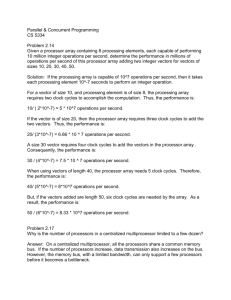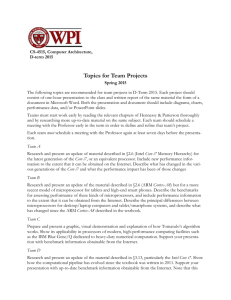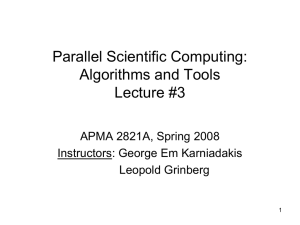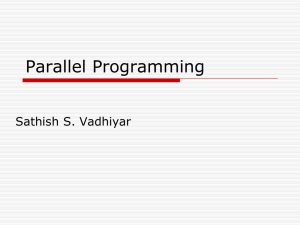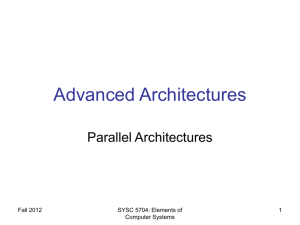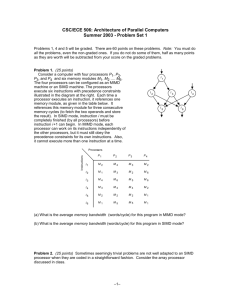Central Processing Unit
advertisement
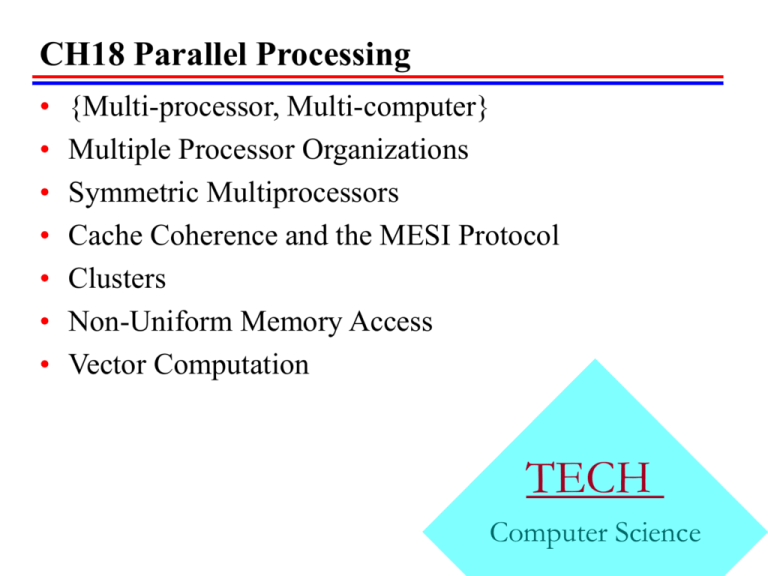
CH18 Parallel Processing
•
•
•
•
•
•
•
{Multi-processor, Multi-computer}
Multiple Processor Organizations
Symmetric Multiprocessors
Cache Coherence and the MESI Protocol
Clusters
Non-Uniform Memory Access
Vector Computation
TECH
Computer Science
=Multiple Processor Organization
•
•
•
•
Single instruction, single data stream - SISD
Single instruction, multiple data stream - SIMD
Multiple instruction, single data stream - MISD
Multiple instruction, multiple data stream- MIMD
Single Instruction, Single Data Stream - SISD
•
•
•
•
Single processor
Single instruction stream
Data stored in single memory
Uni-processor
Parallel Organizations - SISD
Single Instruction,
Multiple Data Stream - SIMD
•
•
•
•
•
•
Single machine instruction
Controls simultaneous execution
Number of processing elements
Lockstep basis
Each processing element has associated data memory
Each instruction executed on different set of data by
different processors
• Vector and array processors
Parallel Organizations - SIMD
Multiple Instruction,
Single Data Stream - MISD
• Sequence of data
• Transmitted to set of processors
• Each processor executes different instruction
sequence
• Never been implemented
Multiple Instruction,
Multiple Data Stream- MIMD
• Set of processors
• Simultaneously execute different instruction
sequences
• Different sets of data
• SMPs, clusters, and NUMA systems
Parallel Organizations - MIMD Shared
Memory
Parallel Organizations - MIMD
Distributed Memory
Taxonomy of Parallel Processor Architectures
MIMD - Overview
• General purpose processors
• Each can process all instructions necessary
• Further classified by method of processor
communication
Block Diagram of
Tightly Coupled Multiprocessor
Tightly Coupled - SMP
• Processors share memory
• Communicate via that shared memory
• Symmetric Multiprocessor (SMP)
Share single memory or pool
Shared bus to access memory
Memory access time to given area of memory is
approximately the same for each processor
Tightly Coupled - NUMA
• Non-uniform memory access
• Access times to different regions of memory may
differ
Loosely Coupled - Clusters
• Collection of independent uni-processors or SMPs
• Interconnected to form a cluster
• Communication via fixed path or network
connections
=Symmetric Multiprocessors
• A stand alone computer with the following characteristics
Two or more similar processors of comparable capacity
Processors share same memory and I/O
Processors are connected by a bus or other internal connection
Memory access time is approximately the same for each processor
All processors share access to I/O
Either through same channels or different channels giving paths to same
devices
All processors can perform the same functions (hence symmetric)
System controlled by integrated operating system
providing interaction between processors
Interaction at job, task, file and data element levels
SMP Advantages
• Performance
If some work can be done in parallel
• Availability
Since all processors can perform the same functions,
failure of a single processor does not halt the system
• Incremental growth
User can enhance performance by adding additional
processors
• Scaling
Vendors can offer range of products based on number
of processors
=Organization Classification (network)
• Time shared or common bus
• Multiport memory
• Central control unit
-Time Shared Bus
• Simplest form
• Structure and interface similar to single processor
system
• Following features provided
Addressing - distinguish modules on bus
Arbitration - any module can be temporary master
Time sharing - if one module has the bus, others must
wait and may have to suspend
• Now have multiple processors as well as multiple I/O
modules
Time Share Bus - Advantages
• Simplicity
• Flexibility
• Reliability
Time Share Bus - Disadvantage
• Performance limited by bus cycle time
• Each processor should have local cache
Reduce number of bus accesses
• Leads to problems with cache coherence
Solved in hardware - see later
-Multiport Memory {many access ports}
• Direct independent access of memory modules by
each processor
• Logic required to resolve conflicts
• Little or no modification to processors or modules
required
Multiport Memory –
Advantages and Disadvantages
• More complex
Extra login in memory system
• Better performance
Each processor has dedicated path to each module
• Can configure portions of memory as private to one
or more processors
Increased security
• Write through cache policy
-Central Control Unit
• Funnels separate data streams between
independent modules (PE, Memory, I/O)
• Can buffer requests
• Performs arbitration and timing
• Pass status and control
• Perform cache update alerting
• Interfaces to modules remain the same
• e.g. IBM S/370
=Operating System Issues
•
•
•
•
•
Simultaneous concurrent processes
Scheduling
Synchronization
Memory management
Reliability and fault tolerance
=Cache Coherence
• Problem - multiple copies of same data
in different caches
• Can result in an inconsistent view of memory
• Write back policy can lead to inconsistency
• Write through can also give problems unless caches
monitor memory traffic
Software Solutions
• Compiler and operating system deal with problem
• Overhead transferred to compile time
• Design complexity transferred from hardware to
software
• However, software tends to make conservative
decisions
Inefficient cache utilization
• Analyze code to determine safe periods for caching
shared variables
Hardware Solution
•
•
•
•
•
•
•
Cache coherence protocols
Dynamic recognition of potential problems
Run time
More efficient use of cache
Transparent to programmer
Directory protocols
Snoopy protocols
Directory Protocols
• Collect and maintain information about copies of data
in cache
• Directory stored in main memory
• Requests are checked against directory
• Appropriate transfers are performed
• Creates central bottleneck
• Effective in large scale systems with complex
interconnection schemes
Snoopy Protocols
• Distribute cache coherence responsibility among
cache controllers
• Cache recognizes that a line is shared
• Updates announced to other caches
• Suited to bus based multiprocessor
• Increases bus traffic
Write Invalidate
• Multiple readers, one writer
• When a write is required, all other caches of the line
are invalidated
• Writing processor then has exclusive (cheap) access
until line required by another processor
• Used in Pentium II and PowerPC systems
• State of every line is marked as modified, exclusive,
shared or invalid
• MESI
Write Update
• Multiple readers and writers
• Updated word is distributed to all other processors
• Some systems use an adaptive mixture of both
solutions
MESI State Transition Diagram
=Clusters
•
•
•
•
Alternative to SMP
High performance
High availability
Server applications
•
•
•
•
A group of interconnected whole computers
Working together as unified resource
Illusion of being one machine
Each computer called a node
Cluster Benefits
•
•
•
•
Absolute scalability
Incremental scalability
High availability
Superior price/performance
Cluster Configurations - Standby Server,
No Shared Disk
Cluster Configurations Shared Disk
Cluster Configurations
•
•
•
•
•
Passive standby
Active secondary
Separate servers
Servers connected to disks
Servers share disks
Operating Systems Issues //
• Failure management
Highly available
Failover
Failback
• Load balancing
Clusters v SMP
• Both use multiple processors for high demand
applications
• SMP is easier to manage
• SMP takes less physical space and less power
• SMP established and stable technology
• Clusters are better for incremental and absolute
scalability
• Clusters are better for availability
=Non-Uniform Memory Access
NUMA
• Uniform memory access
All processors have access to all pats of main memory
Access time to all regions of memory the same
Access time by all processors the same
• Non-uniform memory Access
All processors have access to all memory using load and
store
Access time depends on region of memory being
accessed
Different processors access different regions of memory
at different speeds
• Cache-coherent NUMA
Cache coherence is maintained
CC-NUMA Organization
NUMA Pros and Cons
• Effective performance at higher level of parallelism
than SMP
• Not transparently like SMP
Need software changes
• Availability
Required Reading
• Stallings Chapter 16

